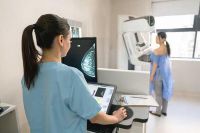About-cancer/screening/screening-tests/zh
Contents
- 1 筛检
- 1.1 有效的癌症筛查测试
- 1.2 结肠镜检查,乙状结肠镜检查和粪便检查(高灵敏度粪便潜血检查和粪便DNA检查)
- 1.3 小剂量螺旋计算机断层扫描
- 1.4 乳腺摄影
- 1.5 巴氏试验和人乳头瘤病毒(HPV)试验
- 1.6 其他筛选测试
- 1.7 甲胎蛋白血液检查
- 1.8 乳房MRI
- 1.9 CA-125测试
- 1.10 临床乳房检查和定期乳房自我检查
- 1.11 PSA test
- 1.12 Skin exams
- 1.13 Transvaginal ultrasound
- 1.14 Virtual colonoscopy
- 1.15 More Information
- 1.16 Related Resources
筛检
有效的癌症筛查测试
癌症筛查测试旨在及早发现癌症,在症状产生之前以及何时更容易成功治疗。 有效的筛选测试是:
- 尽早发现癌症
- 减少定期接受筛查的人死于癌症的机会
- 具有更多的潜在利益大于危害。 (筛查测试的可能危害包括出血或其他物理损伤,不准确的测试结果以及过度诊断,即诊断不会造成问题且不需要治疗的癌症。)
结肠镜检查,乙状结肠镜检查和粪便检查(高灵敏度粪便潜血检查和粪便DNA检查)
已经显示了几种筛选测试可以降低死于大肠癌的风险。 结肠镜检查和乙状结肠镜检查不仅可以及早发现结肠直肠癌,而且可以从一开始就帮助预防该疾病。 这是因为这些测试可以发现异常结肠生长(息肉),可以在患癌之前将其清除。 专家组通常建议对处于大肠癌平均风险中的人进行50至75岁年龄范围的一项检查以进行筛查。有关更多信息,请参阅《检测大肠癌和息肉的试验》技术说明书和PDQ®大肠癌筛查摘要 。
小剂量螺旋计算机断层扫描
该筛查肺癌的试验显示可以减少55至74岁的重度吸烟者的肺癌死亡率。有关更多信息,请参见国家肺癌筛查试验页面和PDQ®肺癌筛查摘要。
乳腺摄影
事实证明,这种筛查乳腺癌的方法可以减少40至74岁的女性(尤其是50岁以上的女性)死于该疾病的死亡率。有关更多信息,请参见乳房X线照片简介和PDQ®乳腺癌筛查摘要。
巴氏试验和人乳头瘤病毒(HPV)试验
这些测试可以单独使用也可以组合使用,可以导致子宫颈癌的早期发现和预防。 它们之所以能够预防这种疾病,是因为它们可以在癌症发生之前发现并治疗异常细胞。 对于那些经过充分筛查并且没有其他高患子宫颈癌风险的女性,通常建议从21岁开始,到65岁结束。 有关更多信息,请参见宫颈涂片和HPV检测情况说明书和PDQ®宫颈癌筛查摘要。
其他筛选测试
仍然可以提供尚未证明有效的筛查测试,特别是对于已知罹患癌症风险增加的人。
甲胎蛋白血液检查
有时会使用此测试以及肝超声检查来尝试在高风险人群中及早发现肝癌。欲了解更多信息,请参见PDQ®肝脏(肝细胞)癌症检查总结。
乳房MRI
此影像学检查通常用于携带BRCA1基因或BRCA2基因有害突变的女性。 具有这些突变的女性罹患乳腺癌的风险很高,并且罹患其他癌症的风险也更高。 有关更多信息,请参阅《 BRCA突变:癌症风险和基因检测》情况介绍和PDQ®乳腺癌筛查摘要。
CA-125测试
这种血液检查通常与经阴道超声一起进行,可用于尽早发现卵巢癌,尤其是在罹患这种疾病的风险较高的女性中。 尽管此测试可以帮助诊断有症状的女性的卵巢癌,并且可以用于评估先前被诊断患有该疾病的女性的癌症复发率,但尚未证明它是有效的卵巢癌筛查测试。 有关更多信息,请参阅PDQ®卵巢癌筛查摘要。
临床乳房检查和定期乳房自我检查
Routine examination of the breasts by health care providers or by women themselves has not been shown to reduce deaths from breast cancer. However, if a woman or her health care provider notices a lump or other unusual change in the breast, it is important to get it checked out. For more information, see the PDQ® Breast Cancer Screening summary.
PSA test
This blood test, which is often done along with a digital rectal exam, can detect prostate cancer at an early stage. However, expert groups no longer recommend routine PSA testing for most men because many prostate cancers detected with PSA testing are not deadly, and early detection and treatment of PSA-detected cancers has not been shown to reduce the chance of dying from prostate cancer. For more information, see the Prostate-Specific Antigen (PSA) Test fact sheet and the PDQ® Prostate Cancer Screening summary.
Skin exams
Doctors often recommend that people who are at risk for skin cancer examine their skin regularly or have a health care provider do so. Such exams have not been shown to decrease the risk of dying from skin cancer, and they may lead to overtreatment. However, people should be aware of changes in their skin, such as a new mole or a change to an existing mole, and report these to their doctor promptly. For more information, see the Common Moles, Dysplastic Nevi, and Risk of Melanoma fact sheet and the PDQ® Skin Cancer Screening summary.
Transvaginal ultrasound
This imaging test, which can create pictures of a woman’s ovaries and uterus, is sometimes used in women who are at increased risk of ovarian cancer (because they carry a harmful BRCA1 or BRCA2 mutation) or of endometrial cancer (because they have a condition called Lynch syndrome). But it has not been shown to reduce deaths from either cancer. For more information, see the PDQ® Ovarian Cancer Screening summary and the PDQ® Endometrial Cancer Screening summary.
Virtual colonoscopy
This test allows the colon and rectum to be examined from outside the body. Although it has not been shown to reduce deaths from colorectal cancer and may reveal possible problems outside the colon that then need to be investigated further, this test may be recommended if it is the only colorectal cancer screening test a person finds acceptable. For more information, see the Tests to Detect Colorectal Cancer and Polyps fact sheet and the PDQ® Colorectal Cancer Screening summary.
More Information
For complete information about screening tests by cancer type, including tests that are being developed and tests that were used in the past, see the PDQ® Cancer Information Summaries: Screening/Detection (Testing for Cancer)
Related Resources
In an Era of Precision Medicine, Testing New Approaches to Breast Cancer Screening

